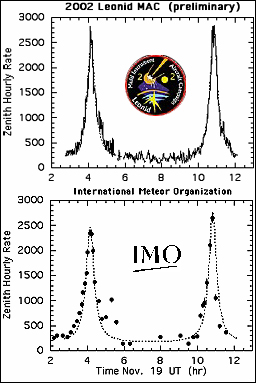|
Leonid MAC |
| home |
| View the shower |
| Mission Brief |
| Science Update |
| Media Brief |
| links |
LEONID DAILY NEWS: November 19, 2002
 Figure 1: Summary of 2002 Leonid storm counts .
Figure 1: Summary of 2002 Leonid storm counts .
The two anticipated Leonid meteor storms occurred much as predicted. European observers saw the peak at 04:09 UT (ZHR = 2,300/hr), while observers in the America's witnessed a storm peaking at 10:50 UT (ZHR = 2,600/hr). Both peaks were narrow, with a full-width-at-half-maximum of only 0.52 and 0.50 hours, respectively. Both peaks were also rich in faint meteors. As a result, the near-full Moon and bad weather at prime observing sites made visual observations from the ground difficult. Nonetheless, viewing from the airborne platforms was spectacular. The graphs above show the preliminary results from 1-minute counts gathered by Morris Jones and seven other members of the flux measurement team on board NASA's DC-8 Airborne Laboratory during the 2002 Leonid MAC mission, as compared to visual observations gathered by the International Meteor Organization . The new observations provide important new data for dust trail models. The dynamic models by Esko Lyytinen et al. and Jeremie Vaubaillon were only minutes off from the observed peak time. The narrow flux profiles demonstrate that the dust trail does not widen over time, as in the models by Lyytinen et al., Asher and McNaught, and Vaubaillon. The measured width is only slightly narrower than predicted by Jenniskens [PDF file ] (0.64 and 0.60 hr, respectively). In addition, the strong showing in Europe confirms the small trail shifts noticed earlier. The most important result may have been the abundance of faint meteors. While predicted in some models, such as that of Jenniskens, the distribution of meteoroid sizes in dust trails is not yet understood. A high background of activity persisted between the two storm peaks. That background may reflect the 1833 dust trail encounter (Lyytinen's prediction put the encounter time at 06:36 UT), or it could be a manifestation of the Leonid Filament.
2002: Nov 19 - Leonid storms rich in faint meteors Oct 22 - Collecting meteoroid debris from snow cover Oct 21 - Highlights COSPAR/World Space Congress Aug 31 - First UV spectrum: Leonid from space 2001: Dec 11 - Shocking Leonid Dec 01 - Moon impacts Nov 26 - Near-IR persistent train emission Nov 24 - Results of near-real time flux measurements Nov 22 - Wowh! Optical meteor spectra 2000: Dec. 25 - Ursid shower circular IMO Dec. 24 - Ursid shows early release of sodium Dec. 23 - Ursid outburst confirmed Dec. 18 - Dec 22 Ursid outburst Nov. 20 - A bacterial fingerprint? Nov. 15 - HCN disappears mysteriously Nov. 14 - Meteor shower from space Nov. 13 - Organic fingerprint Nov. 12 - Train airglow chemistry Nov. 11 - Hard bits and persisting glows Nov. 10 - Meteoroid debris detected Nov. 09 - New meteor picture Nov. 08 - Spin city Nov. 07 - Meteors affect atmospheric chemistry Nov. 06 - Listen to this! Nov. 04 - Fear of heights? Nov. 03 - The pale (infra-red) dot Nov. 02 - Twin showers Nov. 01 - Leonids approaching Earth Oct. 31 - Prospects for Moon Impact Studies Oct. 30 - Comet dust crumbled less fine Today's news
| ||

